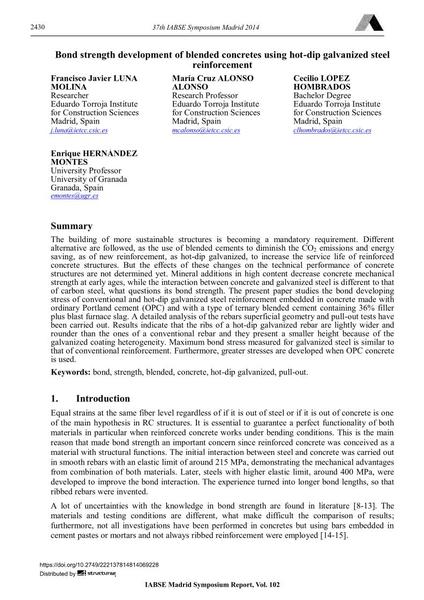Bond strength development of blended concretes using hot-dip galvanized steel reinforcement

|
|
|||||||||||
Bibliographic Details
| Author(s): |
Francisco Javier Luna Molina
María Cruz Alonso Alonso Cecilio López Hombrados Enrique Hernández Montes |
||||
|---|---|---|---|---|---|
| Medium: | conference paper | ||||
| Language(s): | English | ||||
| Conference: | IABSE Symposium: Engineering for Progress, Nature and People, Madrid, Spain, 3-5 September 2014 | ||||
| Published in: | IABSE Symposium Madrid 2014 | ||||
|
|||||
| Page(s): | 2430-2437 | ||||
| Total no. of pages: | 8 | ||||
| Year: | 2014 | ||||
| DOI: | 10.2749/222137814814069228 | ||||
| Abstract: |
The building of more sustainable structures is becoming a mandatory requirement. Different alternative are followed, as the use of blended cements to diminish the CO2 emissions and energy saving, as of new reinforcement, as hot-dip galvanized, to increase the service life of reinforced concrete structures. But the effects of these changes on the technical performance of concrete structures are not determined yet. Mineral additions in high content decrease concrete mechanical strength at early ages, while the interaction between concrete and galvanized steel is different to that of carbon steel, what questions its bond strength. The present paper studies the bond developing stress of conventional and hot-dip galvanized steel reinforcement embedded in concrete made with ordinary Portland cement (OPC) and with a type of ternary blended cement containing 36% filler plus blast furnace slag. A detailed analysis of the rebars superficial geometry and pull-out tests have been carried out. Results indicate that the ribs of a hot-dip galvanized rebar are lightly wider and rounder than the ones of a conventional rebar and they present a smaller height because of the galvanized coating heterogeneity. Maximum bond stress measured for galvanized steel is similar to that of conventional reinforcement. Furthermore, greater stresses are developed when OPC concrete is used. |
||||
| Keywords: |
concrete bond strength hot-dip galvanized blended pull-out
|
||||
